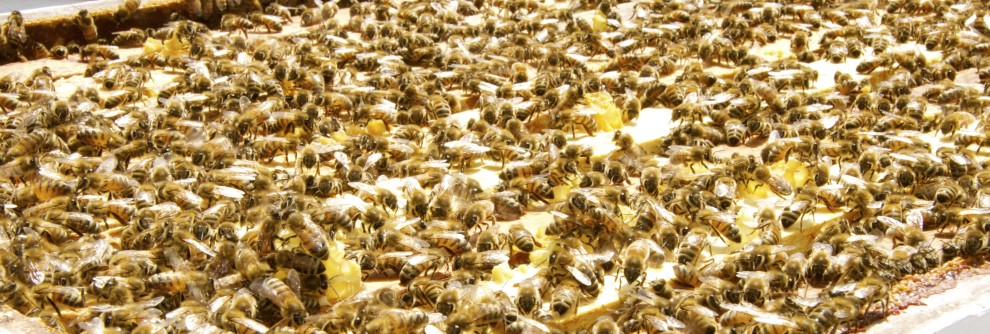-
Recent Posts @ the Buzz
- The 2023-2024 Bee Survey is now LIVE!
- The Reluctant Spring of 2023
- 2022-2023 Bee Survey is OPEN!
- 2021-2022 Survey Announcement
- Surviving Wildfires & Ice storms – 2020-2021 Survey Announcement
- Q & A – Barely Surviving Spring
- Q & A – Treatment Free Studies
- Q&A – Agricultural sprays & our bees
- 2019-20 Honey Bee Survey is on!
- Q&A – cold/snowy loss
Tags
AFB agricultural crops bee disappearance Brood colony loss confusion costly hobby dead bees dead out drone education Feeding fondant future survey hive loss Honey honey flow honey stores mentors mite mite control mites moisture multiple choice nucs overwinter oxalic acid packages PMS pollen pollination queen sanitation season split spraying survey confusion Survey glitch swarm top bar treatments Varroa Varroa mite control Warre yellow jacketsArchives
- March 2024 (1)
- April 2023 (1)
- March 2023 (1)
- March 2022 (1)
- February 2021 (1)
- April 2020 (3)
- March 2020 (1)
- March 2019 (22)
- February 2019 (1)
- July 2018 (2)
- June 2018 (1)
- May 2018 (2)
- February 2018 (1)
- May 2016 (58)
- April 2016 (1)
- February 2016 (1)
- November 2015 (1)
- September 2015 (3)
- August 2015 (1)
- July 2015 (1)
- May 2015 (6)
- April 2015 (29)
Categories
- 2015 (5)
- 2015 Survey (38)
- 2016 Survey (55)
- Carons articles (15)
- Dr (4)
- Q & A (101)
- Results (1)
- Uncategorized (11)
The Reluctant Spring of 2023
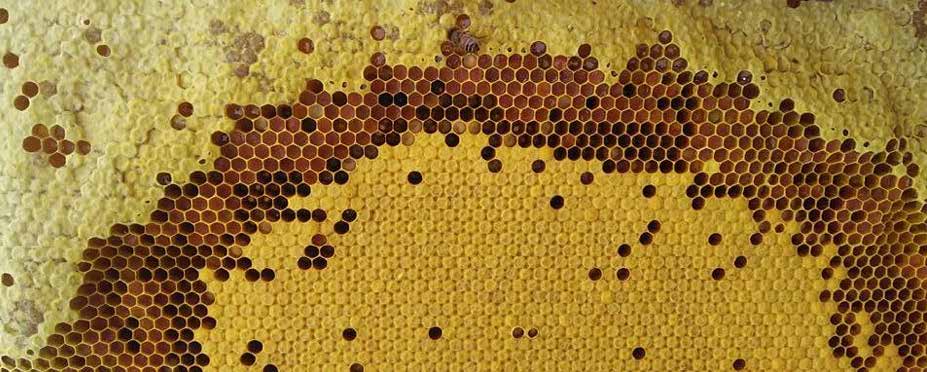
Keeping bees can be an adventure. This years “reluctant” spring has been a challenge. Usually by mid-April we have to split strong colonies or risk colony swarming. This year there were no reports of swarms by mid-April and beekeepers have reported only a few colonies that might be split. In truth early splits this year might mean poor mating of the virgin queens that the queenless split would need to prosper into summer without intervention. On the bright side our early PNWHoneyBee Survey returns are showing lower overwintering losses! Do keep in mind however that with our “reluctant” spring we risk having colonies run out of honey stores. As was the case last year, many beekeepers report adding more sugar candy or fondant candy cakes to their colonies for the last beekeeping season. Reminder – the PNW and BIP annual colony surveys are open until end of month. If you haven’t completed a survey please do so before May 1st.
Posted in Uncategorized
2022-2023 Bee Survey is OPEN!

National and regional loss/management surveys demonstrate the annual loss of bees overwinter fluctuates from one season to the next. It is not the coldest temperatures but fluctuating weather that is hard on bees. By January many colonies have brood, which winter pollen foraging promotes. In January and February colony size and amount of honey stores are most critical to overwintering success Effectiveness of previous season varroa mite control is also a critical factor.
It is still too early to be able to determine how colonies have fared during this winter, although early reports seem promising so far. Increasingly, winter survival models, using the extensive multiple years of loss data, are being utilized to seek to correlate losses with colony managements and environmental factors.
An earlier study from Penn State found overwintering success influenced by higher colony weight and size of the population colonies reached prior to winter. Origin of stock was not important, at least for central Pennsylvania. Higher temperature and precipitation during the warmest seasonal quarter was correlated with improved wintering success. Recently a detailed look at the data from the Bee Informed National Survey linked increased winter colony loss rates with winter weather. Specifically, November mean maximum temperatures and mean February precipitation predict success.
In Oregon and Washington annual colony loss is assessed with the https://pnwhoneybeesurvey.com For Oregon backyarders, the overall trend has been essentially flat over the past 13 years at just under 40% annual colony loss; for commercially managed colonies losses are one-half that level, at just above 20%.
The 2023 survey of the 22-23 winter and 2022 management season will be open for your participation mid-March through April. After you open your colonies and assess your winter success please take the time to enter your data in the survey. It should take less than 5 minutes. Reports by club are posted beginning within a month following survey close April 30th . Can we count on you entering your data and “beeing” among those counted? THANKS.
2021-2022 Survey Announcement
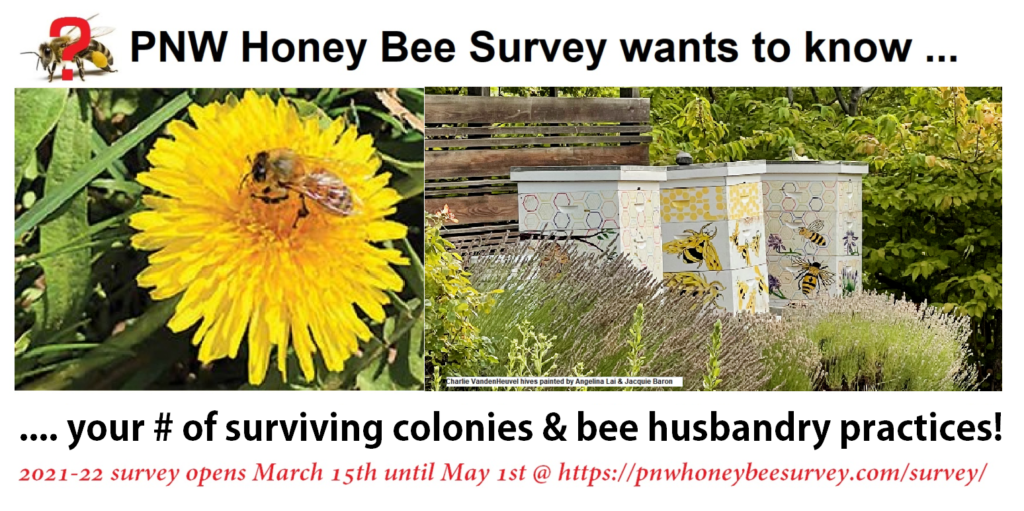
With improving spring weather check colony food stores by hefting at the back of the colony. If you feel the hive is short in required food you could consider feeding a homemade sugar brick until it warms up enough for syrup. Make a sugar brick by mixing a small amount of water to make a thick slurry of cane/beet sugar and letting it stand overnight to solidify. An alternative would be to feed drivert (confectioners) sugar. Do not use brown sugar or any sugar that contains starch.
Peek quickly under the lid & below covers for water staining or sign of excess moisture in the hive. If seen, consider using some form of absorption filler material, aka quilt box, for the remainder of damp months or plan for this addition to next year’s wintering set up. Colonies need to be insulated on the top so moisture does not accumulate under the cover and rain back down on the bees.
Clean bottom boards to clear the path for new bees and save them this task (& honey store energy). This could be something as simple as brushing clear with a down feather for now until the temperatures are above 60 degrees and it’s safe to physically open the hive long enough to clean the bottom board.
The 13th annual Pacific Northwest Honey Bee Loss Survey will open up EARLY this year www.pnwhoneybeesurvey.com/survey You can start entering your overwintering successes/losses and management on March 15th . The survey will be available until May 1st. Please consider downloading and filling out the note sheet to aid in quick survey entry. Many have found that this simple resource has been key to have on hand in the bee yard throughout the year not only to track items but to remind of alternative bee husbandry options.
We hope to see great health in our PNW honeybees and fellow beekeepers this spring!
Posted in Uncategorized
Surviving Wildfires & Ice storms – 2020-2021 Survey Announcement
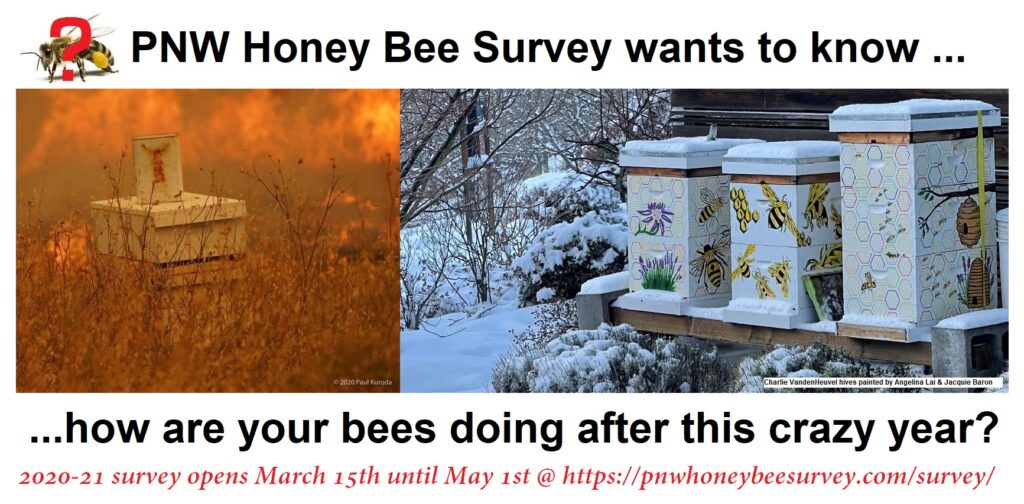
After our mild January the colder February is better for our bee colony overwintering in order to slow colony expansion.
Once the weather warms check on food stores by hefting at the back. It is too early to feed syrup as we do not want to stimulate or add to moisture stress.
If you feel the hive is short in required food you could consider feeding a homemade sugar brick until it warms up enough for syrup. Make a sugar brick by mixing a small amount of water to make a thick slurry of cane/beet sugar and letting it stand overnight to solidify. An alternative would be to feed drivert (confectioners) sugar but do not use brown sugar or any sugar that contains starch.
Peek quickly under the lid & below covers for water staining or sign of excess moisture in the hive. If seen, consider using some form of absorption filler material aka quilt box for the remainder of damp months or plan for this addition to next year’s wintering set up.
Clean bottom boards to clear the path for new bees and save them some labor (& honey store energy). This could be something as simple as brushing clear with a down feather for now until the temperatures are above 60 degrees and it’s safe to physically open the hive long enough to “change the underwear”.
The 12th annual Pacific Northwest Honey Bee Loss Survey will open up EARLY this year on March 15th and be available until May 1st. Please consider downloading and filling out the note sheet to aid in quick survey entry. Many have found that this simple resource has been key to have on hand in the bee yard throughout the year not only to track items but to remind of alternative bee husbandry options.
Lastly, if you would like an email reminder when the survey opens please visit https://pnwhoneybeesurvey.com/resources/reminder/ today.
We hope to see great health in our PNW honeybees and fellow beekeepers this spring!
Q & A – Barely Surviving Spring
Q – Both of my hives were well until mid-March. One has started to collapse. I am trying to save it but my hopes are not high. As of the end of March, it’s still alive.
A – We find some colonies that barely survive until the spring but then do not recover and die in late spring – We do the survey in April to enable respondents to include this information. If it is too cool or the bees are not heavily fed sugar syrup they can not reverse the decline. The survey was started early this year as the bees started early. You can amend the survey if this colony doesn’t make it and you left an email previously for us to link it with.
Q & A – Treatment Free Studies
Q – Attempted Treatment Free management on half the colonies, lost most of the TF colonies. 245 in fall, 130 in spring = 47% loss
A – Here is the information for the research. This was TF study form Sweden – it took 5 years – with heavy looses each year until there was (and it is continuing) better survival without treatment for varroa mites: Abstract (Of Bond Method study): An isolated honey bee population (N = 150) was established on the southern tip of Gotland, an island in the Baltic Sea. After infestation with 36 to 89 Varroa destructor mites per colony, they were unmanaged and allowed to swarm. For over six years colonies were monitored for swarming, winter losses, infestation rate in the fall, and bee population size in the spring. Winter mortality rate decreased from 76% and 57% in the third and fourth years, to 13% and 19% in the fifth and sixth years. Swarming rates increased from zero the third field season to 57.1% and 36.4% in the last two years. The mite infestation on adult bees decreased during the last two years, from 0.47% in the third year to 0.19% and 0.22% respectively. Our data suggest that a host-parasite co-adaptation has occurred ensuring survival of both the host and the parasite.Article in Apidologie 2006 by Fries, Imdorf and Rosenkrantz https://www.researchgate.net/publication/42384375_Survival_of_mite_infested_Varroa_destructor_honey_bee_Apis_mellifera_colonies_in_a_Nordic_climate
• NOTE A recent PLoS one paper (Dec 2018) by Srinivas, Locke, Granberg and de Miranda in their introduction stated this about the Gotland Bond method study bees: The Gotland mite-resistant honeybee population exhibits a number of relevant colony level mite-resistant traits, such as small colony size [29] and reduced mite reproductive success, that together limit the mite population growth relative to mite susceptible colonies [30,31], leading to considerably lower mite infestation rates, especially towards the end of the season [32].One of the more recent findings from this population was a tolerance to DWV, since colonies of the Gotland population survive with high DWV infection levels that are otherwise lethal to mite-susceptible honeybees [32]. Additionally, the Gotland mite-resistant honeybees appear to be resistant to other honeybee-infecting viruses such as Black queen cell virus (BQCV) and Sacbrood virus (SBV), which diminish by several orders of magnitude before the critical wintering phase of the honeybee life cycle https://journals.plos.org/plosone/article?id=10.1371/journal.pone.0206938 [numbers refer to citations]
2019-20 Honey Bee Survey is on!
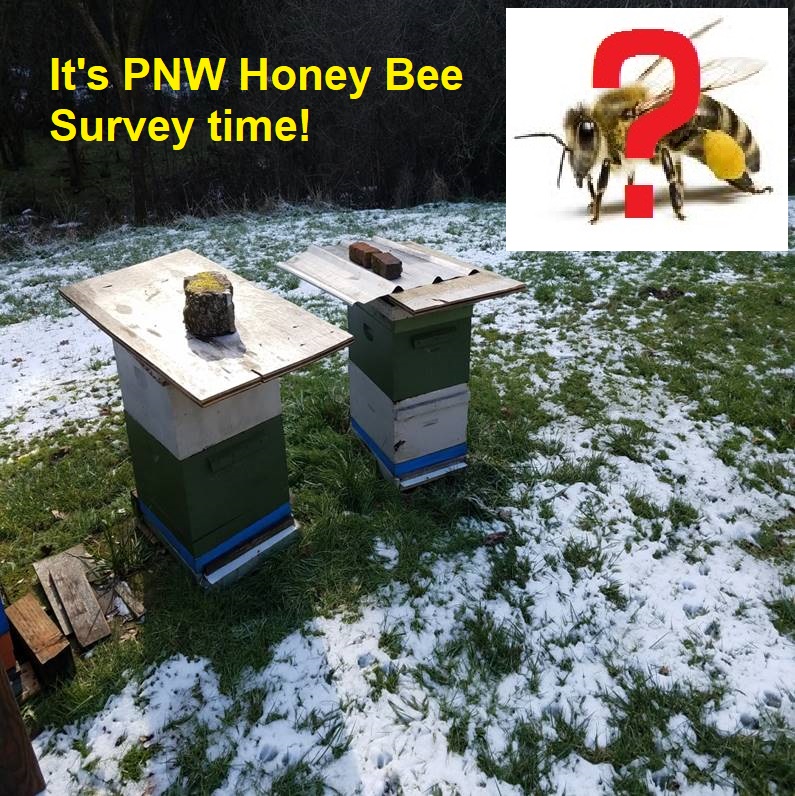
The PNW loss survey is now available and will be open through April at https://pnwhoneybeesurvey.com/survey/. I trust your bees got through the Ides of March cold spell. If you entered data and something changes you can re-enter using same email and make changes – we CAN still lose colonies. Sugar is tough to find; if bees are able to get out there is a good bloom available but don’t neglect colonies that need supplemental feeding. Thanks for remaining the vital part of this research tool – Dewey
Posted in Uncategorized
Q&A – cold/snowy loss
Q – I feel that the very cold/snowy Feb-mid March was very hard on my bees. In late Jan, 5/6 were alive and had good food stores. By early March, only 1/6 were alive. Moisture was a problem too.
A – February was cold and wet but March temperatures were averaging 10 degrees below normal until the one nice week we had (3rd week). However for bees, whatever the temperature, the time after they start brood rearing (in January usually) until they have consistent forage conditions (often not until April) is a critical time and we lose too many colonies during this period. March can be a very “cruel” month for bees and their keepers.
Posted in Q & A
